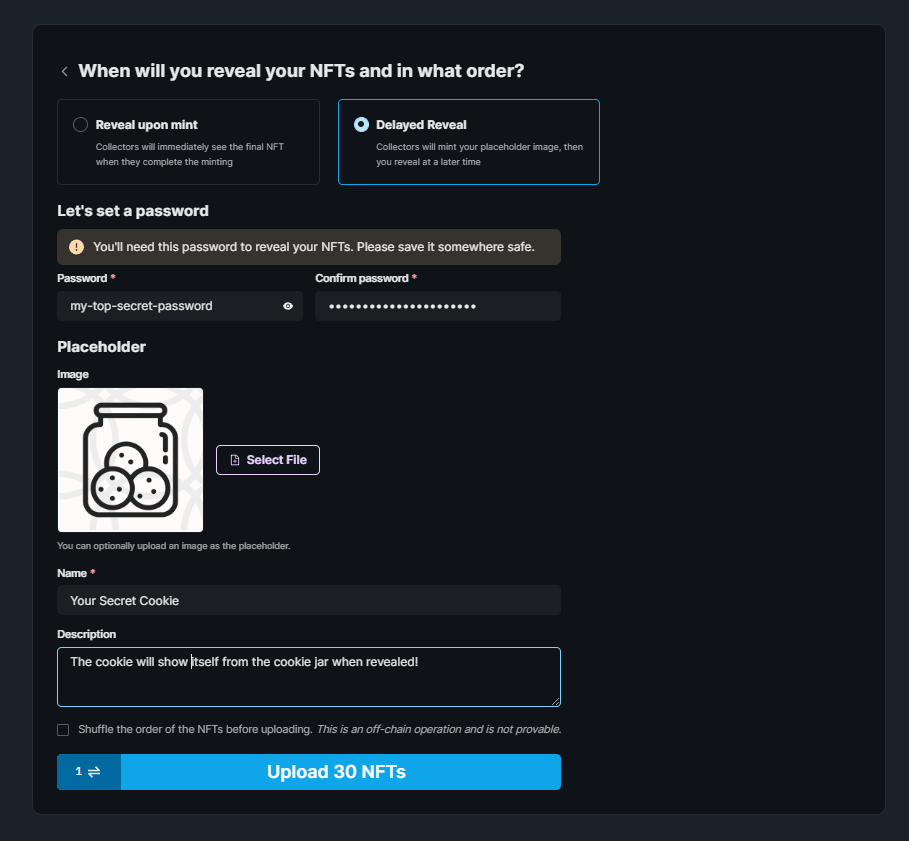Delayed Reveal
The DelayedReveal smart contract extension is meant to be used with any ERC721 or ERC1155 NFT smart contract. It lets you create batches of 'delayed-reveal' NFTs.
'Delayed reveal' is a mechanism by which you can distribute NFTs to your audience and reveal the metadata of the distributed NFTs, after the fact.
Import
import "@thirdweb-dev/contracts/extension/DelayedReveal.sol";
Available functionality
| Functionality | Description |
|---|---|
reveal | Lets an authorized wallet reveal a batch of delayed reveal NFTs. |
Implementing the Contract extension
Import the contract extension and make your contract inherit it.
// SPDX-License-Identifier: MIT
pragma solidity ^0.8.0;
import "@thirdweb-dev/contracts/base/ERC721Base.sol";
import "@thirdweb-dev/contracts/extension/DelayedReveal.sol";
/**
* The `DelayedReveal` extension is meant to be used with an ERC721 or ERC1155 NFT contract as a base.
*
* As an EXAMPLE, we'll use the extension with the `ERC721Base` contract to create delayed-reveal NFTs.
*/
contract MyNFT is ERC721Base, DelayedReveal {
/**
* STEP 1: For our example, we'll store the address of the contract's deployer.
* The objective of this to later make it so that only the contract's
* deployer is authorized to reveal our delayed-reveal NFTs.
*/
address public deployer;
constructor(
string memory _name,
string memory _symbol,
address _royaltyRecipient,
uint128 _royaltyBps
) ERC721Base(_name, _symbol, _royaltyRecipient, _royaltyBps) {
deployer = msg.sender;
}
/**
* STEP 2: We'll create a function that mints our delayed reveal NFTs.
*
* @param to This is the address of the recipient of the minted delayed reveal NFT.
*
* @param beforeRevealURI This is the metadata of the NFT (i.e. a placeholder) before the true
* metadata of the NFT is revealed
*
* @param encryptedPostRevealURI This is the *encrypted* true metadata of the NFT. Read more about
* the role of encryption in the delayed reveal process in the linked blog:
* https://blog.thirdweb.com/delayed-reveal-nfts
*/
function mintDelayedRevealNFT(
address to,
string memory beforeRevealURI,
bytes memory encryptedPostRevealURI
) public {
// We'll use the NFT's `tokenId` as an identifier for the NFT, in the delayed reveal process.
uint256 tokenId = nextTokenIdToMint();
// Store the encrypted true metadata for the NFT.
_setEncryptedBaseURI(tokenId, encryptedPostRevealURI);
// Mint the NFT in its un-revealed state using `mintTo`, made available by `ERC721Base`.
mintTo(to, beforeRevealURI);
}
/**
* STEP 3: Create a mapping where we'll store the true metadata URI of an NFT (if it is a delayed-reveal NFT)
* after it has been revealed.
*/
mapping(uint256 => string) private postRevealURI;
/**
* STEP 4: Complete the `reveal` function made available by the `DelayedReveal` contract extension.
*
* @param tokenId The tokenId of the delayed-reveal NFT whose metadata we want to reveal.
*
* @param key This is the key initally used to encrypt the true metadata of the NFT. Read more about
* the role of encryption in the delayed reveal process in the linked blog:
* https://blog.thirdweb.com/delayed-reveal-nfts
*/
function reveal(uint256 tokenId, bytes calldata key)
external
override
returns (string memory revealedURI)
{
// Get the true metadata of the NFT using the `getRevealURI` function made available by the
// `DelayedReveal` contract extension.
revealedURI = getRevealURI(tokenId, key);
// We'll delete the encrypted metadata URI of the NFT which we're revealing.
delete encryptedBaseURI[tokenId];
// Now store the revealed, true metadata URI for the NFT.
postRevealURI[tokenId] = revealedURI;
}
/**
* FINAL STEP: The tokenURI function returns the metadata URI for the NFT of a given tokenId.
*
* In this function, we'll check whether we've stored a 'post reveal' URI for
* the given tokenId. If so, we'll return that URI. Else, we'll return what
* our inherited `ERC721Base` contract's `tokenURI` function returns.
*/
function tokenURI(uint256 tokenId)
public
view
virtual
override
returns (string memory)
{
if (bytes(postRevealURI[tokenId]).length > 0) {
return postRevealURI[tokenId];
}
return super.tokenURI(tokenId);
}
}
Unlocked Features
Configure a password and placeholder metadata of your delayed reveal using the dashboard or the SDK.
If you use deploy you'll be able to select the delayed reveal option when you batch upload your NFTs.

You can also set up and release a delayed reveal using the SDK: